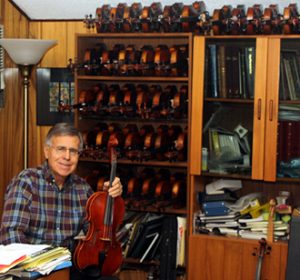David Herman: Violin Bow Restoration Expert
 David Herman learned to make violin bows while teaching violin in the Sewanhaka school district, a profession he entered because he loved music. Growing up in Williamsburg, Brooklyn, David’s first musical memories were of a violin maker in a small shop. “I remember falling in love with a violin with curly maple ribs, and the sound it made when he plucked it. From that time on I always enjoyed looking for violins with that curly maple. My parents arranged for me to study violin with Louise Behrend at the Henry Street Settlement House.”
David Herman learned to make violin bows while teaching violin in the Sewanhaka school district, a profession he entered because he loved music. Growing up in Williamsburg, Brooklyn, David’s first musical memories were of a violin maker in a small shop. “I remember falling in love with a violin with curly maple ribs, and the sound it made when he plucked it. From that time on I always enjoyed looking for violins with that curly maple. My parents arranged for me to study violin with Louise Behrend at the Henry Street Settlement House.”
As a school orchestra teacher, David frequently needed to send the school’s violins and bows for repairs. It was at this time that he discovered the art of restoration and repairing. He began studying and making his own bows at that time. “I start with a piece of wood called pernambuco – which only comes from one place – in Brazil. This wood is both strong and pliable. The bow is carved from this in either an octagonal or round shape.” Bows consist of two elements: the frog and the actual stick. “The ‘frog’ – which is the mechanical mechanism which tightens and loosens the hair, is made of ebony. The frog has metal work, silver work, pearl work on it, and screw mechanisms – it is very involved. The stick itself is eventually curved to what is called a ‘camber’ with an alcohol lamp – which is a clean heat. It maintains its shape. We use horse hair, that is stretched from one end to the other – and then we put rosin on which creates friction and sound on the violin.”
Like other instruments, a bow can have different sounds. As David explains “A denser piece of wood will give a brighter sound. A softer piece of wood will give a more mellow sound. A player can choose what would be more appropriate for their instruments. The workmanship must look like God put it here.” David makes his own varnishes, just as violin makers do. The bow’s weight varies depending on whether it is to be used on a violin, a viola, or a cello.
“The greatest pleasure for me is seeing the smiles on the faces of people who are pleased with the work and pleased with the product, and to hear youngsters come and play beautiful music with these instruments and tools. I like to hold up the violin and the bow and ask them ‘Which one is the instrument?’ Most people would point to the violin but it’s really both, but the bow is like the breath of a singer.”
Visit David at this web site.
